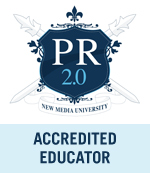I have som thoughts on creativity that I’d like to have your feedback on. Entering into the public relations industry, I have had a very strained relationship with creativity from the start. Compared to our older and more well-funded cousin advertising, public relations sure goes as the less creative of the two. Advertising is simply a more creative craft, most would argue.
I was ok with this. You do not need creativity for creativity’s sake, I argued. And instead of learning from the advertising industry, I took a lot of lessons from the management consultants and their way of thinking and applied these processes on modern public relations. I even developed a distaste for advertising, manly because of two reasons; one, I did not believe in what the advertised messages were trying to tell (sell) me and two, I did found it a bit vulgar to simply buy space to get your say - instead of letting the messages earn their place instead.
Also, I thought that you could figure out how to get people to talk and journalists to write - by simply using science. By leveraging the journalists’ hunger for conflict, you could help clients earn publicity by tweaking the right stories. No creativity, just a solid standardized process based on understanding of basic human psychology.
My theory worked very well, and for a long time I was sure that I would have a great career in public relations without being especially creative. Since I didn’t feel like a creative person, the idea appealed to me. But the paradigm I had created for myself soon started to crack.
The problem was, that my best work came from rare moments of ingenious creativity. These ideas made my processes run ever so smoothly, with less work on my part as well as resulting in infinitely better outcomes. One client for instance, wanted to raise awareness on their recruitment services. My process stated that I should compare them to their competitors, do a SWOT analysis and position them using conflict in the sweet spot. A lot of hard work and a lot of calls, but it would have worked. But in this particular case, I was not working on the project - I was merely helping out participating in an internal brainstorm.
For some reason, I suggested that we should ask people how many of them who had lied in their resumés at some point in their lives. I do not remember the exact statistics, but the results really proved that recruitment services have an important part to play. And it made the news - bigtime. The creative idea produced results for the client which were unbelievable good compared to the processed results. Only with less work involved. And this history kept repeating itself, over and over again.
The creative pitches constantly derived more praise and results than the daily grind, producing solid results over and over.
My theory was shaken at this point. What made matters worse, was the internal brainstorm sessions. I dreaded them, because I could not think when I was in them. I stopped listening to what my colleagues were saying in order to concentrate, and after one hour of blocking out the chatter, then - maybe! - I could deliver at least one solid idea. And it was not like that particular idea always made the headlines at all; it simply was the one and only creative idea I could manage to put into the mix after a whole hour of brainstorming. It was depressing.
So, I decided to become more creative. But how? I took the only path I knew to take - I created a logical process for it. I studied creativity and developed a couple of theories and then I simply put these theories to work.
My findings were that creative people are intuitive and often highly visual. They also seemed to be able to go with their subconscious notions quite more freely than other, as if they knew how to trust their instincts to their work for them. I studied quite a few of the geniuses of history and found that they all had a tendency to write things down. They were also highly productive and their creative outcomes seemed to be based on quantity rather than quality. Like if you get 100 ideas, chances are at least one of them will be ingenious.
The next step was to keep reading in order to find scientific explanations to these characteristics. It proved easier than I thought.
Our mind is visual to begin with and it is just in the later stages of human history we have been forcing ourselves to be linear in our way of thinking. Add to this our consciousness which in itself stops us all from becoming autistic by squelching whatever breaks our patterns, known in communication theory as selective perception. So, I started to visualize basically everything. Not by force, but by clinging on to the images that simply shows up in your mind if you relax and let them.
By visualizing solutions and accomplishments they started to come to me. It was only later I learnt that the technique been quite popular amongst athletes of different kinds. I could even visualize myself walking around in a world were the problem was already solved, and simply by looking around, observing this fantasy world, the solution would become clear to me. It is truly fascinating, that if you visualize, you could often times see the problem with all its complexities as well as the solution in its whole, all at once, just at a glance.
This seemed to be a factor also when speed reading. If you stop reading each word aloud in your head, and instead watch the whole sentence all at once, you will find that you have no problem with understanding it. In a split second. It is difficult to look at the sentences instead of reading each word, but it works. And it gives you a hint on how much more powerful your brain really are - when used right.
 photo © 2009 Aidan O’Sullivan | more info (via: Wylio)
photo © 2009 Aidan O’Sullivan | more info (via: Wylio)
But what about all that productivity? All those scribblings, notebooks, and ideas that seemed so important to so many creative geniuses, what role did they play? After reading up on neuro linguistic programming, extreme programming, dog psychology, human social psychology, neurology, I soon realized how enforcement works. Also, my studies in linguistic and how children absorbs grammar came well into play here.
Let’s say the brain produces a thought, like lifting your right arm consciously. When you then lift your right arm, neural impulses will then send a feedback impulse, telling the system that this really works. After a few repetitions and some trial and error, you have control over your right arm. Athletes are of course constantly fine tuning their motor skills this way, which enables them to hard code astonishing and refined movements patterns which most of us then can admire with awe.
This makes it quite easy for a word class sprinter to finish a 100 meter race in under 12 seconds, but basically impossible for other human beings. For them it is simply like riding a bike.
But what would happen if your thought told you to lift your right arm, but instead you squelched that notion, forcing your arm to stay put? Now here is where it is starting to become really interesting. In all brains, there are billions and billions of connections between your neurons. Depending on how you use your body in the physical world, neural feedback will be sent back to these systems, creating patterns over time. Because those used connections that get positive feedback from physical activity are reinforced, while those connections who do not get feedback actually will dissolve.
This can explain why it is so much more difficult to learn a new language as an adult. Your linguistic patterns have already been hard coded into your brain, in fixed patterns which lets you use your native tongue just as effortless as the athlete is performing his basic skills. Speaking a language is not a small mental task. From a neurological perspective, the task itself is actually so complex that we should all call ourself geniuses. But if your language patterns are already reinforced, you must often try to fit another language into the same patterns.
This is also of course why it is easier for someone who is fluent in four languages to learn a fifth, than it would be for someone to learn a second language, especially if the language differ a lot in basic grammar. I realized why I, as I was learning English and German in school, always had to write new words again and again in order for me to be able to put them to use in a complex structure, like linear sentence, without effort and whenever I needed to. Knowing what I know today, I should also have visualized the words and me using them in different contexts.
When it then came to creativity, the basic theory was simple. When I got an idea that was at least somewhat good, I wrote it down. Not in order to remember it, but in order to let physical feedback tell my brain that it should reinforce those brain patterns that constructed the idea in the first place. The effects of this technique really worked wonders for my creativity. When I got an idea, I visualized it, looked at it from different angles, studied it - and then wrote it down. However crazy or out of context - I wrote it down.
I could suddenly stop what I was doing in the gym just to find a piece of paper where I scribbled down an idea on how to construct a weather balloon. I have no interest in weather balloons whatsoever, but I stayed to true to the process. It came to me for whatever reason, so I visualized it, and scribbled it down. If I was reading a book, and for some reason saw a pink elephant emerge somewhere in the back of my mind, I scribbled the elephant down in the margin, even if the book itself was about public relations.
This was - and is! - crazy for sure, but I really wanted to reinforce subconscious visualizations, since basically all my research and reading was pointing to it being the key to original and ingenious thought.
At first, I got maybe one useless idea a day but one useful idea over a period of seven days. Quite soon, I had seven ideas a day, but only one useful. Inspired by the whole process and mostly all the ideas, I started to do more with the ideas than just writing them down. I actually started to leverage quite a few of them in my work and in my private life. This almost doubled the reinforcing effect and the percentage of useful ideas just started to go up, almost eliminating the useless ideas. A lot of people ask me how I can be so productive, but I do not feel that way at all - I feel that there is way too little time to follow-up on all the exciting ideas, concepts and impulses that effortlessly comes to me in an almost magic and never-ending stream of visuals.
I still do not like brainstorming sessions, since I produce much better results alone with a whiteboard and a magic marker. I must physically do something with my ideas directly as they emerge, or otherwise it is like my own brain gets angry with me for not taking the process seriously.
This process in itself actually showed me something very interesting about creativity. Picture a transparent brain floating in mid-air. Then you slow everything down, down, down. Do you see that transparent brain floating in mid-air? Now, see the thoughts, the electric impulses moving from neuron to neuron, like small but slowed-down flashes of electrical pulses. You are looking at a brain with a high intensity of creative thoughts, so what do you see? My bet is that you see a highly interconnected brain were different impulses travel easily in paths were they never traveled before and every unexpected turn is rewarded by a green flash of light, the positive physical feedback, keeping the of neural pathways open at all times - and actually turning them from narrow pathways to modern freeways of the mind.
It is almost - if you are seeing what I am seeing? - like those little impulses are happy and playful, judging by the energetic way that they move back and forth in the brain. As if unexpected thoughts are to be expected. For me, this vision made me realize, somewhat ironically I agree, that there is no basic contradiction between science and creativity, or between process and irregularity.
I better write this down really… well, I guess I just did. So what’s next?

 Follow @DoktorSpinn on Twitter
Follow @DoktorSpinn on Twitter









